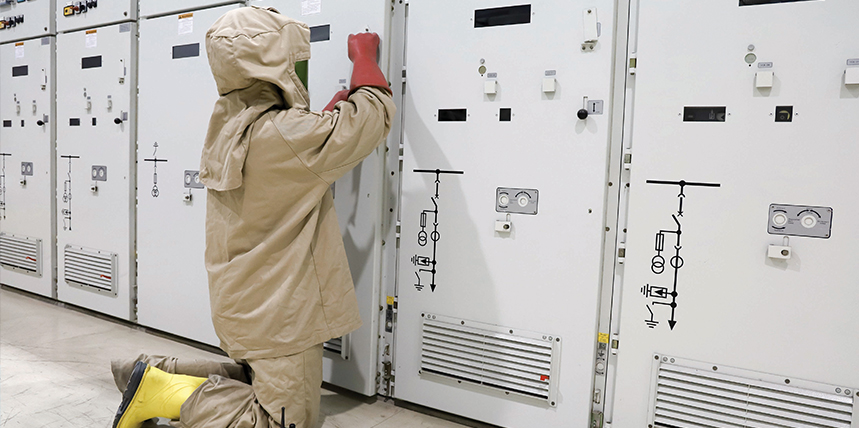When performing condition analysis on medium-voltage circuit breakers located in metal-clad switchgear, it is necessary to be aware of all potential hazards. The person performing the condition analysis must be qualified to perform the task and have a solid understanding of each possible hazard they may encounter as well as ways to minimize the risks.
To better understand the hazards involved with the analysis, testing, and maintenance of medium-voltage breakers, let’s look at the sources that contribute to each hazard.
ELECTRICAL ENERGY
Electrical energy is the first and most obvious hazardous energy source that could cause injury while working on any electrical equipment, and improperly performed lockout/tagout is the primary cause of many injuries when performing maintenance on medium-voltage breakers.
Being aware of the breaker compartment layout is equally important. Many injuries and incidents occur while opening the breaker and then performing the visual verification that it is open. In many cases, the compartment is isolated or physically a significant distance from the equipment being operated. Double-check the markings and nomenclature for each to ensure how it is arranged. As a secondary method to verify there is no load, utilize an ammeter within the switchgear, if one is associated with that equipment. During this step, electrical and mechanical energy become potential hazards depending upon the type of breaker. It is also necessary to isolate the electrical source and discharge any of its stored energy. Ensure that the breaker is not removed from service while in a closed position. Always check that the breaker is open prior to racking.
Electrically de-energize the breaker from its primary energy source and ensure the breaker is disconnected from all sources of power, both AC and DC, if applicable. Once de-energized, verify that the breaker is at a zero-energy state using the manufacturer’s approved method. Verify the accuracy of the detection or voltage-measuring device against a known source, then check for zero energy on the de-energized equipment, and then re-test the detection equipment against another known source. This will verify that the device was functional during the check. Testing for voltage will require its own level of personal protective equipment (PPE) depending upon the voltage and test procedure given in NFPA 70E 2021 Table 130.7(C)(7)(A) and 130.7(C)(15)(A) or (B). If an arc flash analysis has been performed on the equipment, use this information to determine your potential exposure and the PPE that will be necessary to mitigate it. It may also be necessary to lockout and tagout the actual compartment the breaker has been removed from.
MECHANICAL ENERGY
However, electrical energy isn’t the only energy that requires lockout/tagout. Breakers also contain a large amount of mechanical energy. This energy must be removed prior to servicing, or serious injury could occur. Once the breaker’s mechanical energy has been discharged, then lockout and tagout the charging mechanism, if feasible. Ensure that remote operating handles are tagged in a local or manual mode. This will prevent inadvertent operation of the breaker.
Gas and hydraulic operating mechanisms may be pressurized. Ensure the unit is depressurized and/or discharged and the source of the pressure is disabled. Once disabled, this source must also be locked out/tagged out prior to performing maintenance.
OTHER PHYSICAL HAZARDS
Gravity is an easily forgettable energy that must be controlled. The sheer size and weight of medium-voltage breakers makes them difficult to rack in and out or to maneuver around. When available, utilize remote racking equipment. Mechanical lifting devices should be used when available to move the breaker to an area where it can be serviced.
INSTALLATION OF TEMPORARY PROTECTIVE GROUNDS
Refer to the manufacturer’s recommendations, OSHA 29 CFR 1910.269, and NFPA 70E for specific guidance on grounding locations and sizing of grounds required for the task. Grounds must always be applied upstream and downstream of the equipment and as close to the work as possible. Always ensure that all work on electrical equipment is done between grounds when possible and that the grounds are removed once the work is complete. The best means for accomplishing this is to utilize a tracking method for all grounds applied and removed. This can take the form of a handwritten log or a computer spreadsheet.
PROPER PERSONAL PROTECTIVE EQUIPMENT
After verifying that the breaker is electrically de-energized, rack out the breaker. If available, utilize remote racking and unracking equipment to minimize exposure. Ensure that proper personal protective equipment is utilized for the class of breaker that will be serviced. Refer again to the arc flash analysis and to the tables in NFPA 70E and OSHA 29 CFR 1910.269 depending on whether these are available and the type of equipment. These indicate the required level of protection for the class of breaker being worked on, which will prevent electrical shock and protect personnel from arc flash. The tables provide information based upon known values of the short-circuit current available, the clearing time in cycles, and minimum working distance. If those factors are unknown, more information must be gathered prior to performing the work to ensure personnel safety.
CHEMICAL HAZARDS
Chemicals can be a hazard depending upon the type of breaker. Sulfur hexaflouride (SF6) gas is used as an insulator in some breakers. Caution must be taken with damaged breakers that exhibit arcing because this can form disulfur decaflouride, which is an extremely toxic gas. SF6 is denser than air, so it displaces oxygen in low-lying areas. Ventilation must be used to prevent gasses from being trapped.
Some lubricants and cleaners may pose a respiratory and skin irritant if used in enclosed areas or on bare skin. Knowledge of the material, reading its label, and checking the safety data sheet (SDS) is advised to identify any potential health effects. Using the proper type of PPE is necessary when using some cleaners and lubricants. Nitrile gloves, safety glasses, a face shield, and even respiratory protection may be needed in some cases.
CONCLUSION
There are many things we must continue to watch out for when performing maintenance and testing on a breaker:
1. Obtain all service bulletins, maintenance documents, arc flash studies, and manuals prior to beginning work for that specific device.
2. Review relevant prints and one-line diagrams associated with the equipment.
3. Establish a safe work area and barricade off the work area.
4. Perform a pre-job brief with all employees on site performing the work, impacting the work, or being impacted by the work.
5. Wear proper PPE for the task being performed.
6. Disconnect the breaker control circuit and test equipment before performing visual or mechanical inspections and maintenance.
7. Verify that there is zero energy (test, check, test) and discharge all stored energy, including pressurized gasses or mechanical energy.
8. If possible, lockout and tagout all sources of energy.
9. Connect grounds where and if applicable and track them.
10. Identify, visually mark, and/or flag the equipment being worked on.
Following these steps can led to a safer work environment when performing maintenance and testing of medium voltage breakers.
 Paul Chamberlain has been the Safety Manager for American Electrical Testing Co. LLC since 2009. He has been in the safety field for the past 20 years working for various companies and in various industries. He received a BS from Massachusetts Maritime Academy.
Paul Chamberlain has been the Safety Manager for American Electrical Testing Co. LLC since 2009. He has been in the safety field for the past 20 years working for various companies and in various industries. He received a BS from Massachusetts Maritime Academy.
 Scott Blizard has been Vice President and Chief Operating Officer of American Electrical Testing Co. LLC since 2000. During his tenure, Scott acted as the Corporate Safety Officer for nine years. He has over 25 years of experience in the field as a Master Electrician, Journeyman, Wireman, and NETA Level IV Senior Technician.
Scott Blizard has been Vice President and Chief Operating Officer of American Electrical Testing Co. LLC since 2000. During his tenure, Scott acted as the Corporate Safety Officer for nine years. He has over 25 years of experience in the field as a Master Electrician, Journeyman, Wireman, and NETA Level IV Senior Technician.
